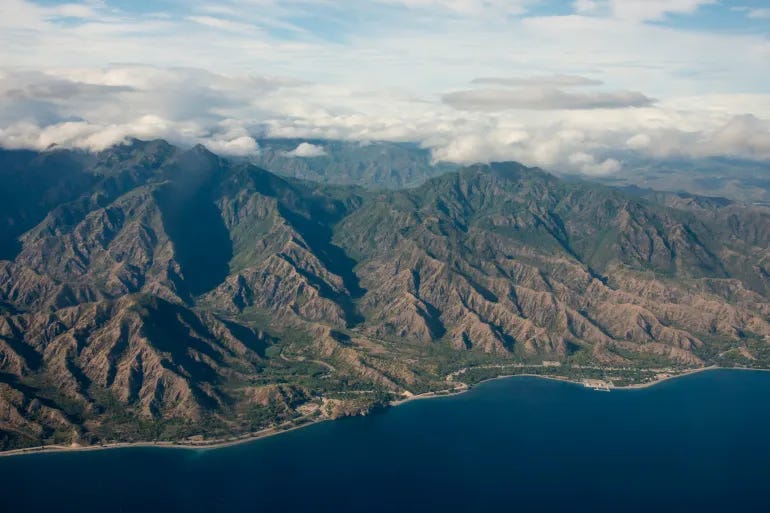Ancient Human Habitation: New Discoveries from East Timor’s Laili Rock Shelter
Manage episode 445174604 series 3444207
Archaeological discoveries in East Timor’s Laili rock shelter have unveiled evidence1 of ancient human habitation dating back approximately 44,000 years. This finding, led by an international team of archaeologists, contributes significantly to understanding the migration and adaptation patterns of early humans in Southeast Asia. The evidence gathered from stone tools, animal bones, and sediment analysis paints a picture of human life in this region over 35,000 years before the construction of the Egyptian pyramids.

The Laili Rock Shelter Discovery
The Laili rock shelter, located in northern East Timor (also known as Timor-Leste), has been the focus of extensive research conducted by archaeologists from Australian and UK universities, including the Australian National University (ANU) and Flinders University. Excavations revealed thousands of stone artifacts and animal bones, indicating human presence approximately 44,000 years ago.

Sediment layers dating between 59,000 and 54,000 years were also analyzed, providing insights into environmental conditions over millennia. However, the absence of clear human evidence from these earlier layers suggests that human presence in the region did not begin until around 44,000 years ago. Archaeologist Shimona Kealy of the Australian National University noted that this "arrival signature" challenges previous assumptions about early human migration to Timor.
Understanding Human Arrival in Timor
The timeline established by these findings offers new perspectives on when early human populations reached the island of Timor. Distinguished Professor Sue O’Connor of ANU highlighted the significance of these results, explaining that the absence of human activity earlier than 50,000 years ago indicates a later-than-expected arrival of humans in the region.
The sediment analysis and associated artifacts suggest that early human populations likely adapted to the region’s environmental conditions and exploited its resources, demonstrating the flexibility and resilience of these groups. The findings, published in Nature Communications, provide a more precise understanding of early human migration in Southeast Asia.
The Broader Archaeological Landscape of Southeast Asia
The new discoveries in East Timor are part of a broader archaeological narrative in Southeast Asia, which includes neighboring regions such as Indonesia and Australia. The area is known for its ancient artifacts and evidence of early human populations. For instance, on the Indonesian island of Sulawesi, archaeologists discovered a 45,500-year-old life-size ochre painting of a warty pig2, potentially the oldest known rock art on Earth.

Basran Burhan, an Indonesian archaeologist and Griffith University PhD student who led the survey that uncovered the Sulawesi painting, commented that the image demonstrates how humans hunted and valued these animals for both sustenance and artistic expression. Previous discoveries in Sulawesi include a 44,000-year-old painting depicting half-human hunters pursuing wild animals with spears and ropes, further emphasizing the region’s ancient cultural richness.
Southeast Asia’s Ancient Cultural Heritage
Beyond East Timor and Sulawesi, Australia holds some of the oldest continuous cultural heritage sites globally, reflecting its Indigenous populations' long history. Archaeological evidence in Australia dates back at least 60,000 years, highlighting the ancient roots of Aboriginal cultures. In Murujuga, located in northwestern Australia, an estimated one million petroglyphs showcase rock carvings from as far back as 40,000 years ago. These carvings depict animals like the now-extinct nail-tailed wallabies and thylacines (Tasmanian tigers).
Recently, the Murujuga Cultural Landscape was nominated for UNESCO World Heritage status, emphasizing its importance as a site of significant cultural and historical value. Kim Wood, CEO of the Murujuga Aboriginal Corporation, stated,
“Murujuga is a deeply storied landscape where the ancestors of Ngarda-Ngarli lived and thrived for thousands of generations.”
She highlighted that every part of this landscape contains the history, culture, and lore that have shaped the region for over 50,000 years.
Challenges Facing Cultural Heritage Sites
While efforts are being made to protect and preserve such cultural heritage sites, challenges persist. In Australia, some traditional owners have expressed concerns over the potential destruction of sites like Murujuga due to industrial development projects. A gas project in the area threatens the preservation of the ancient petroglyphs, raising questions about the balance between cultural conservation and economic interests.
The urgency for protective measures is underscored by past events, such as the destruction of the Juukan Gorge shelters in 2020. Located north of Perth, the site, dating back 46,000 years, was destroyed by mining activities, leading to international outrage and the resignation of the CEO of the mining company Rio Tinto. An Australian government report titled Never Again called for stricter regulations to prevent future destruction of sacred cultural sites.
Conclusion
The discoveries from East Timor’s Laili rock shelter offer valuable insights into the migration, adaptation, and survival strategies of early human populations in Southeast Asia. This region, rich in ancient artifacts and cultural heritage, provides a unique window into the lives of early humans and their interactions with the environment. As archaeological research continues to uncover new findings, it is crucial to protect and preserve these ancient sites to ensure that the history they hold is safeguarded for future generations.
Shipton, C., Morley, M. W., Kealy, S., Norman, K., Boulanger, C., Hawkins, S., Litster, M., Withnell, C., & O’Connor, S. (2024). Abrupt onset of intensive human occupation 44,000 years ago on the threshold of Sahul. Nature Communications, 15(1), 1–15. https://doi.org/10.1038/s41467-024-48395-x
Brumm, A., Oktaviana, A. A., Burhan, B., Hakim, B., Lebe, R., Zhao, J.-X., Sulistyarto, P. H., Ririmasse, M., Adhityatama, S., Sumantri, I., & Aubert, M. (2021). Oldest cave art found in Sulawesi. Science Advances, 7(3). https://doi.org/10.1126/sciadv.abd4648
9 епізодів




